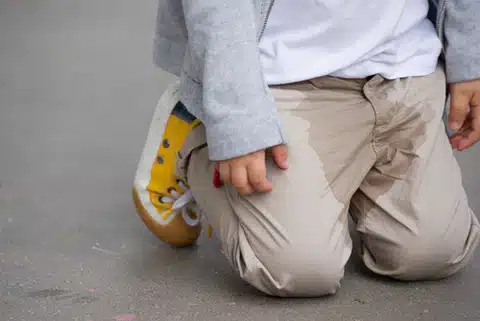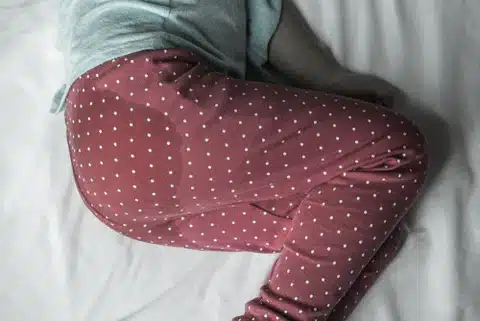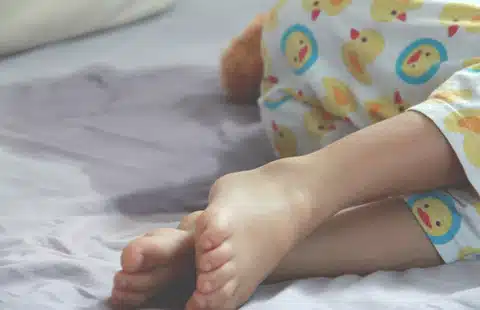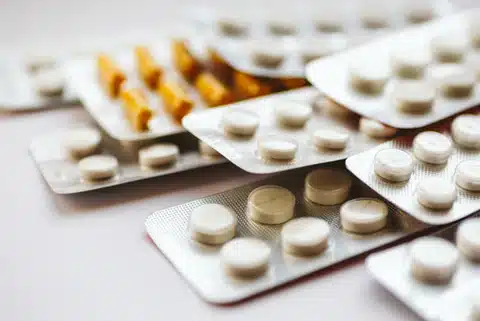Bedwetting, also known as nocturnal enuresis, is the involuntary release of urine during sleep, and is very common. Almost a third of 4-year-olds wet the bed. By the time children reach 6 only 1 in 10 still wet the bed, and by 10 only 1 in 20 continue to wet the bed. Bedwetting is a problem for many school-aged children but the good news is that, for most children, the problem resolves over time. But what about the children who bed wet beyond these ages? And what if a child is day wetting or soiling themselves? Today we are going to discuss if incontinence in children is normal.

What is Urinary Incontinence?
Essentially, urinary incontinence is the loss of bladder control. In children 4 and under, it’s normal not to have full bladder control. But as children become older, they become more able to control their bladder. When wetting happens with a child whose old enough to control their bladder, it’s known as incontinence. Incontinence can happen during the night and day. While incontinence can be frustrating, it’s important to be patient and remember your child’s not at fault. They are not in control over their incontinence. Thankfully, there are many ways to treat incontinence in children.
When is Incontinence a Problem?
Children will have incontinence from time to time. And it can take some children longer than others to learn how to control their bladder. Girls tend to have better bladder control than boys. Which means that incontinence is often diagnosed in girls earlier than it is in boys. In fact, girls can be diagnosed with incontinence as young as 5. Some boys, unfortunately, may not be diagnosed until the age of 6 or older.

Types of Child Incontinence
Doctors generally divide child incontinence into four main types. A child can have one or more of these types of incontinence:
Daytime wetting (diurnal enuresis)
This is wetting or incontinence during the day. Most children have gained daytime bladder control by the age of 4. If a child still regularly wets during the day, after the age of 4, you should seek professional advice.
Soiling
Soiling or faecal incontinence is when the bowels are emptied in places other than the toilet. Even after a child is toilet trained, there may be occasional accidents with soiling in their underwear. Again, however, if this is happening regularly over the age of 4, seek professional advice.
Bedwetting (nocturnal enuresis)
Bedwetting or incontinence is the involuntary passing of urine that occurs at night during the main sleep period. Again, most children are able to sleep through the night without needing the bathroom, by the age of 4. If bedwetting is regularly occurring after the age of 4, especially if your child is also wetting during the daytime or is regularly soiling, it is important to seek professional advice.

What Causes Incontinence?
It is important to know that urinary incontinence has various causes. In some cases, urinary incontinence occurs because a child’s bladder, genitals, urinary tract and/or urethra hasn’t developed properly, meaning they don’t work properly. Other children have overactive bladders, meaning their bladders don’t properly store urine. This can make your child suddenly feel like they have to wee, which causes them to wet themselves. Conversely, other children can have underactive bladders, meaning they can’t properly empty their bladder when they go to the toilet. This means urine can dribble out before or after they go to the toilet.
Constipation and UTIs (urinary tract infections) can cause temporary incontinence for some children. Constipation, especially, can cause pressure on the bladder, making it more likely for a child to wet themselves. Stressful life events can also cause incontinence. This can include starting school, the birth of a new sibling, divorce, etc. These stressors can make it hard for some children to focus on going to the toilet by themselves, meaning they may accidentally wet themselves as a result.
Incontinence has a wide range of causes. In the case of night-time incontinence, the cause if often not known. But some possible causes may include one or more of the below:
- Anxiety
- Attention deficit hyperactivity disorder (ADHD)
- Constipation
- Diabetes
- Feeling the bladder is full while asleep
- Genetics
- Lack of antidiuretic hormone (ADH) during sleep
- Obstructive sleep apnoea (OSA)
- Overactive bladder
- Slow physical development
- Small bladder
- Structural issues in the urinary tract
- Urinary tract infection
Daytime incontinence can be caused by one or more of the following:
- Anxiety
- Caffeine
- Constipation
- Neglecting going to the bathroom
- Not completing urination when using the bathroom
- Overactive bladder
- Small bladder
- Structural problems in the urinary tract
- Urinary tract infection (UTI)
How is Incontinence Diagnosed?
It is best to take your child to your general practioner (GP) for a formal diagnosis of incontinence, as well as ways to treat it. Your GP will likely ask about their medical history so be sure you tell the GP if:
- Other members of the family have/had incontinence
- Your child urinates during the day and how often
- The urine is dark or cloudy or has blood in it
- Your child drinks in the evenings and how much
- They have been constipated/are constipated
- Your child has been experiencing recent stress in their life
- The have symptoms such as pain or burning when urinating

When Should I Take My Child to See a GP?
It’s important to have to have your child checked by a GP if they are older than 4 years and:
- is experiencing urinary incontinence more than once a month
or
- has never had a period of dryness
Your GP may also perform a physical exam to try and find the cause of the incontinence. This may involve a physical examination of your child’s stomach, lower back, and genitals. They may also request you have urine tests and/or blood tests done. These are all done to look for potential medical problems like infections or diabetes.
Your GP might also refer you on to a continence or medical specialist to ensure your child has the best treatment possible.
How Do You Treat Incontinence?
There a different treatment options for urinary incontinence. The right treatment for your child will depend on what’s causing the incontinence and what your GP or specialist recommends.
Behaviour Modification
The most common treatment for incontinence in children is behaviour modification. This is also known as urotherapy. The treatment involves teaching your child how their body stores and gets rid of wee, and also teaches them about:
- The importance of going to the toilet regularly
- Why they shouldn’t hold on when they need to wee
- Recognising the signs of needing to wee
Your child might even be asked to keep a diary of how often they go to the toilet, how long they go between wee, and how often they wet themselves, to see their improvement and encourage better toilet use. The GP or specialist may also ask your child to keep track of how much they drink and how much wee they do when they go to the toilet. As part of this treatment, your child will probably be asked to urinate at set times throughout the day.

Medication
In some cases of incontinence, the GP or specialist might prescribe medication to treat the incontinence. The type of medication will depend on the cause of the incontinence. Your GP or specialist will explain why medication is needed, what it does, what the side effects are, etc.
Other Treatment Options
Depending on the cause of the incontinence, there are other treatment options available. Some are simple and some are far more complex. In the case of complex incontinence, your GP will likely refer you to a specialist.
In many cases, incontinence in children goes away over time and doesn’t need to be treated. But if treatment is needed, there are many simple methods that can help. These methods include:
Avoid Caffeine – caffeine can be found in soft drink, lollies, chocolate, and more. Caffeine is a diuretic which means it makes your child urinate more, which could cause incontinence.
Bladder Training – this method includes exercises and urinating on a schedule.
Changes in Fluid Intake – you may be told by your GP to give your child less fluids to drink at certain times of the day or evening.
Counselling – working with a counsellor can help your child cope with life changes and other stresses that may be causing the incontinence.
Medications – some medications can boost ADH levels or calm overactive bladder muscles to prevent incontinence.
Scheduled Night Urination – this involves waking the child up at the same time each night to urinate.
Use a Moisture Alarm – this handy sensor detects wetness and sounds an alarm. This prompts your child to get up and use the bathroom.
You can work with your GP to find the best solution for your child and the particular source of their incontinence.
Tips for Managing Incontinence in Children
It is important to remember that your child can’t control the problem without help. Make sure you don’t scold or blame them, and that family members and friends don’t tease them. This will only make things worse. Keep in mind that, in most cases, children will outgrow incontinence while others are easily treated with the help of your GP or a specialist.
Protect your child’s mattress with a fitted plastic sheet and make sure you have a change of clothes on hand while out and about.
Holistic Incontinence carries a wide range of products to help you manage incontinence at any age. Explore our products today or ask our friendly staff for more information or advice!
